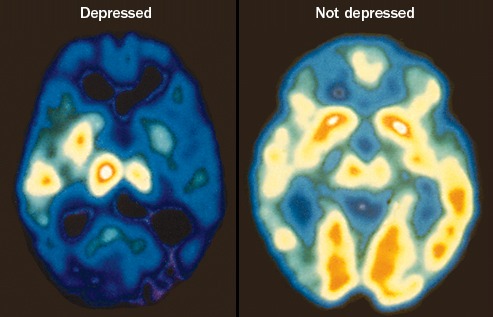A powerful discussion
Students open up about mental health

Mayo Foundation for Medical Education and Research
These PET scan images compare the brain of a patient with depression and the brain of a patient without. The decrease in red and white areas indicates a decrease in brain activity because of the disorder, which student Susan Smith has struggled with for three years.
October 4, 2016
Between Twitter campaigns and Buzzfeed videos, it seems as if the dialogue about mental illness has begun to open up in the past few years. This encouragement of honest, progressive discussion acts as a significant first step in combating the societal stigma surrounding mental health.
It can be shocking to understand the sheer number of teenagers who are affected by mental illness. The National Institute of Mental Health reports that half of all lifetime cases of mental illness begin before the age of fourteen, meaning that many cases develop in high school. The National Alliance on Mental Illness quantifies that 20 percent of people aged 13-18 have, or will have, a mental health condition. This may be a revelation, but it’s a reality for many teens, even some at Starr’s Mill.
Student Susan Smith* has had her own struggle and is making an effort to speak out. Smith herself lives with both anxiety and depression. Her mental illnesses can have a great impact on her life, but that impact can be difficult to communicate to others. It is impossible for her to make someone understand exactly how she feels, but she can illustrate it to the best of her ability with words.
Smith is a member of the speech and debate team, an activity that has given her an outlet for her advocacy. She has constructed a speech which she will recite at several state competitions this year. “The main reason I’m giving this speech is because I want people to know that these illnesses are in fact real, because a lot of people think they aren’t. I want people to understand that it’s okay [and] you’re not alone,” Smith said.
In her speech, Smith describes various mental illnesses and conveys those experiences to her audience. Even though part of her message involves the frustrating, saddening aspects of mental illness, she feels that it’s paramount to understand that there can be a happy ending. “A main part of the oratory speech is to have some sense of light,” Smith said. “I explain that there’s a lot out there, there’s a lot of people to talk to, and there’s a lot of ways to cope with these illnesses.”
Anxiety is a part of life not only for Smith but for adults and teenagers around the world as well. Anxiety can come in many forms, such as general anxiety, panic disorder, or social anxiety. The condition can interfere with sleep patterns and influence everyday life with undesirable feelings of restlessness, tension, and lack of concentration. Many individuals may have temporary feelings of nervousness during stressful times, but having an anxiety disorder is something very different. For Smith, the disorder is a constant fact of life, and though there are times of heightened anxiety and panic, it always seems to be looming in the background.
Smith describes her anxiety as a feeling of uneasiness and terror of what’s about to happen. Her anxiety has made her unable to attend haunted houses or other scare-filled events. The rush of people in the hallway along with a fear of being late to class can also spur the feeling. It can surface any time that she’s under pressure, even in the middle of class. “I feel like everyone is looking at me,” said Smith. “That’s when I start shaking and I have to [physically] tap something.”
Anxiety often stems from what Smith’s therapist calls “wrong thoughts.” These anxiety-fueled impulses can appear at any time and are irrational in nature. “You think a meteor is going to hit the world in ten seconds, and then your mind spirals from there,” Smith said.
Calm Clinic, an organization for those with anxiety, elaborates on this feeling. “It’s not just the content of the thought. It’s how it feels as though your thoughts are firing at such a fast pace that you cannot even remember what the last thought was, and by the time you have a new thought another one immediately takes its place.”
The obvious solution for Smith is to stop the spiral and to remind herself that a meteor hurtling toward Earth or a fatal car crash are far from probable and nothing to worry about, but having anxiety can impede this ability. Even if someone gets better at consciously explaining to herself that the thoughts are untrue, the subconscious mind and body can remain shaky, uncertain, and afraid.
These uncontrollable feelings of worry in everyday life can dramatically affect a person’s self- esteem. Maslow’s Hierarchy of Needs states that a person must be recognized and appreciated in order to flourish, but anxiety can often directly endanger any sense of worth. Both mild and severe cases may stir up feelings of alienation or confusion. An individual suffering from anxiety disorder may ask herself why no one else appears to feel the same way she does or if she’s the only person experiencing such symptoms.
Smith commented that in instances of major anxiety she “feels like an idiot” and that “people think she’s faking it.” This insecurity has been one of the most difficult aspects of anxiety for her to deal with. “I really hate the self-conscious part of it,” Smith said. “People see me in class, and they probably think I’m a freak.”
Having this condition has made her feel different, and that loneliness and loss of belonging feeds into a cycle of negativity. This is why anxiety and depression often go hand in hand.
According to HealthyPlace, a mental health site, about 85% of those affected by depression could be diagnosed with general anxiety. It is not scientifically certain why these two mental illnesses often occur together, but the correlation between them is notably strong. Despite this, it should be noted that these conditions can certainly occur independently of each other and that not everyone with depression also has anxiety and vice versa.
To have depression is not to be merely upset. In order for depression to be professionally diagnosed, the feelings of despair have to exist for longer than two weeks. Symptoms of depression vary, however, it’s much more than a brief feeling of sadness. Depression survivor Tim Lott described the feeling in a piece for The Guardian as “much more complex, nuanced and dark than unhappiness-more like an implosion of self.”
For Smith, illogical patterns of depression are a huge source of frustration. “All I can think is ‘why can’t I just be normal, why can’t I just be consistently happy?’ But since it’s a disease, it just doesn’t go away, no matter what’s happening,” Smith said.
One of the main ways to combat depression is to talk to someone. Help from a professional can often be a key step in coping with depression and other mental illnesses. This fact can be distressing to hear, considering that around 80 percent of those suffering from depression are not seeking treatment, and 80 to 90 percent of those individuals could recover quickly and successfully.
Smith’s experience with her professional therapist has been positive, but it took a long time for her to accept help, let alone develop a close relationship with her therapist. The general societal stigma against the mentally ill in society makes sufferers, including Smith, afraid of seeking the treatment they desperately need. “I’ve been depressed for three years now, and it took me two and a half years to get help for it,” Smith said.
In the end, though, the choice to begin therapy had an invaluable effect on her life. “People misunderstand therapy,” Smith said. “They think they have to be a certain kind of ‘messed-up’ to go, but it’s for anyone. Therapy is somewhere you can vent. I’ll be talking to [my therapist] and as I keep talking, I realize more things. In the moment I don’t know what to do, but when I see her, it all makes sense.”
For mentally ill individuals trying to find help and recovery, stigma is a significant barrier. The actions of others can exacerbate the negative effects of both anxiety and depression. When those who don’t struggle with mental health issues make offhand comments such as ‘we have so much work, I’m going to have a panic attack,’ or ‘these notes make me want to kill myself,’ it’s frustrating for Smith in particular. “It just really irritates me because that is not in any shape or form the illness,” Smith said. “[Suicidal thoughts] are something that you really have to experience to get. You don’t realize it until you have the pills in your hand, when you’re literally contemplating it.”
Though the feelings associated with mental illness can be hard to understand for those who haven’t experienced them, Smith feels adamantly that it’s not at all hard to be sensitive. Reporter Thu-Huong Ha offers a few ways in a Ted article, including avoiding certain belittling terms, reaching out to friends, and speaking up.
Smith has attended one tournament this season with her speech. She has mixed feelings about how it went, and has been altering her work in the meantime. “They were listening, but not understanding. They didn’t seem changed,” Smith said.
Her main goal is to enliven her speech with a heightened sense of emotion and pertinence, instead of the more informational style she originally settled on.
One of the students she talked with for the speech was Elliott Jones*, another student at Starr’s Mill. In addition to his interest in film and fashion, Jones has obsessive-compulsive disorder.
OCD is classified by the International OCD Foundation as involving both obsessions, which are uncontrollable, repeated thoughts, and compulsions, or behaviors carried out to neutralize obsessions.
Jones’ personal experience with OCD has included an extensive morning routine. Showers could be longer than an hour and a half and nightly teeth brushing could be for twenty minutes at a time. “It got so bad that I would have to wake up three hours before school started,” Jones said.
Many issues can arise when the validity of OCD itself is questioned. The term “OCD” tends to be used in everyday conversation, simply as an expression of one’s orderliness. This normalization can lead to confusion, which means far more harm than help. “It’s about having an open mind and knowing that there’s science behind it,” Jones said. “There is a physical, neurological difference.”
In the media recently, there has been much attention toward the “over sensitive” nature of individuals. Jones feels that with regards to mental illness and OCD, context is key. “Pay attention, and be respectful depending on the situation that you’re in,” said Jones. “There’s no one set of rules, in my opinion.”
Both Smith and Jones are multi-faceted complex individuals. Excelling in school and flourishing in their respective social environments, these students have shown that mental illness is not an insurmountable barrier.
Anyone, whether Elliott, Susan, or the student who sits in front of you in first period, could be mentally ill. There is no way to detect it. “You can’t categorize people with mental illness. You’re not going to be able to point them out. They have the same interests that you do. They just have to deal with something that you may not know about,” Jones said.
*The names of these students were changed in accordance with guidelines from the Federal Educational Rights and Privacy Act which “generally prohibits the improper disclosure of personally identifiable information derived from education records.”







